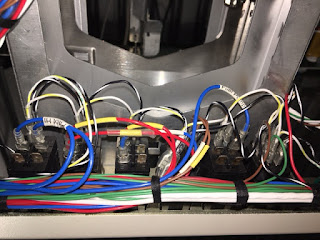Lots of progress in the last few months. Here is a summary:
The engine is in and wired. At this stage, the instructions get a little sparse so it takes some time to figure out what others have done and decide on the best course. One area of isolationism is the fuel flow sensor, that red cube in the pictures. The firewall forward kit does not make provisions for it. Fortunately, my firewall forward kit had an extra fuel hose for the tail dragger version of my plane. I was able to use this extra hose to connect the red cube. The fuel lines are a little longer than I like, but adequate.
Secondly, the position of hole in the firewall for the mixture cable I didn't like. I ended up moving it next to the throttle cable. The new location might make it more difficult to change the oil, but that only happens once every 25 hours (once a month I hope). In addition, the factory location did not work with the length of cable that was included in the firewall forward kit. ( I am unusual because most builders install a carbureted engine; but me, naw, I had to go fuel injected. More Power)
Lastly, I am using the manifold pressure port on the right side of the engine. This required a longer hose to the sensor. Earls in Lawndale, CA made up a new line for me while I waited. What a great resource in the LA area when I visit.
The last bit of interior painting was done on the throttle quadrant plate. I thought this would be too flimsy, but once attached to the back up cable support, this became very rigid.
The last thing I have to figure out on the engine side of the firewall is how to plumb the fuel hose from the throttle body, on the bottom of the engine, to the spider fuel distributor on the top. The Lycoming factory hose is too short. If I used the factory hose, it would make a mess of the baffles. I will have to order a new hose once the baffles are installed.
My next step is to finish all the testing of the avionics to make sure there are no more wiring changes, and then install the last top skin on the fuselage.



































